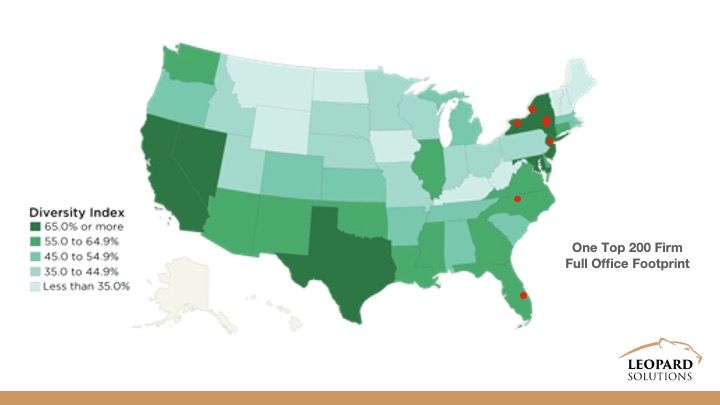Diversity in Law: Expressed through Geography
Following a pivotal Supreme Court ruling that significantly weakened affirmative action protections, the responsibility for promoting equal opportunity for underrepresented groups has become decentralized. Institutions and individuals, often grappling with implicit biases, are now entrusted with addressing this issue. In this context, diversity remains a crucial topic in firm discussions. Leopard Solutions is committed to shedding light on deficiencies and progress through data. Get more information on our Diversity Probability Index.
While ethnic diversity within the Top 200 law firms has historically shown slow progress, there was a concerning 1.3% decline between 2022 and 2023. Many firms emphasize diversity as a core value but hiring practices do not reflect these sentiments. A study titled “176 Years Later: Real Life Stories of Black Male Lawyers in Corporate America” highlights the challenges faced by black male lawyers at Fortune 500 companies, including leaving the legal industry due to hostile work environments (30%) and feeling more scrutinized than white peers (74%). Gender bias is also prevalent in the courts, with women attorneys frequently subjected to demeaning behavior.
Beyond social considerations, cultivating a diverse workplace in law firms is strategically sound, contributing to economic growth, innovation, and increased courtroom success. General Counsels often favor diverse outside counsel teams, perceiving an advantage with juries. However, the responsibility for change should not rest solely on one party but involve all stakeholders to break free from the status quo.
Analyzing ethnic and gender diversity requires a deeper dive than average data allows. Geographic breakdowns reveal that 38% of the Top 200 law firms have ethnic diversity under 15%, with specific cities like Atlanta, Birmingham, Cincinnati, Philadelphia, and New Orleans hosting firms with 10% or less ethnic diversity. Conversely, cities like Los Angeles, New York, Boston, and Washington D.C. show higher diversity concentrations.

Examining the firm with the lowest diversity number in the database reveals a deliberate choice, as their offices are in states with high diversity. A detailed breakdown of their hiring patterns since 2019 indicates a notable need for more diverse hires despite the availability of diverse candidates.
Highlighting the link between diversity and prosperity, statistics from the Top 50 firms compared against the Top 200 emphasize the positive correlation between diverse representation and success. Embracing diverse hiring practices, locally and through university recruitment, is a social equity imperative and a pragmatic business decision. Breaking away from referral hiring and exploring innovative approaches is essential to reduce homogeneity and foster a diverse workforce.
This is an abstract based on the article recently published on JDSupra.
Posted on



